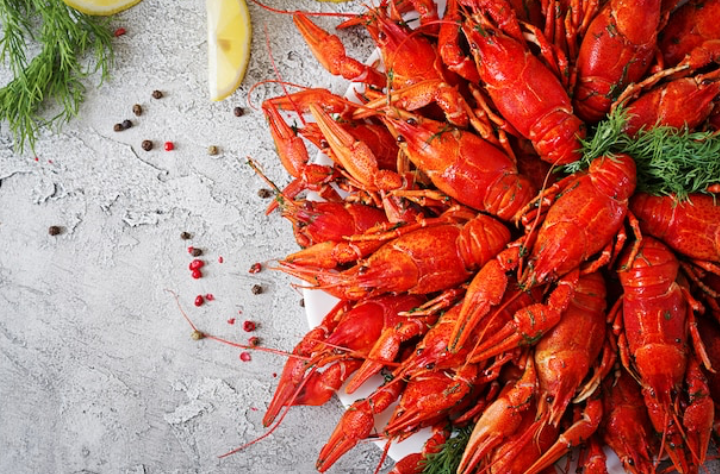
Annual Greasing of the Poles Returns to New Orleans!
February 6, 2022
Deer Carcass Export Ban Into Effect in Tensas, Franklin and Madison Parishes Due to CWD
February 6, 2022By W. Ray McClain and John Sonnier
Few things symbolize Louisiana culture and cuisine like a festive crawfish boil. Wild crawfish are harvested each year from the vast Atchafalaya River Basin, and approximately 184,000 acres of culture ponds in Louisiana are used to produce more than 100 million pounds of live crawfish annually. The majority of this produce is consumed within the state, most of which is in the form of whole crawfish boiled in spices.
First-time consumers of this delicacy are often cautioned to avoid the crawfish with straight tails and eat only the ones with curled tails. Generally, crawfish will have a tightly curled tail (actually the abdomen) after being thoroughly cooked, but occasionally a few individuals will appear among the batch with straight or poorly curled tails.
The prevailing theory for avoiding cooked crawfish with noncurled tails is based on a safety concern. The theory goes that cooked crawfish with straight tails were dead before cooking and, without knowing how long the animals had been dead or how they were stored, it is best to avoid consuming them.
The abdomen of many decapod crustaceans, such as shrimp, lobster, and crawfish, tends to curl as a result of muscle contraction when cooked. Obviously, if muscle tissues in the abdomen are sufficiently deteriorated by degradation or decomposition, then the ability of the abdomen to contract would clearly be affected. However, discerning food quality or safety issues in cooked crawfish simply by observing the degree of curl in the abdomen may not be reliable. For example, we have routinely observed a small number of individuals with various degrees of noncurled abdomens after cooking, when it was certain the crawfish were alive only minutes before cooking. A basic study was initiated to investigate this under controlled conditions. Live, dead and live-but-restrained crawfish were boiled individually, and the perceived degree of curl of the abdomen was measured.
On five different dates over the course of a season, portions of live crawfish were intentionally and quickly dispatched, and then the dead and remaining live crawfish were placed in a cooler at 38-42 degrees F. After five days in the cooler, half the live crawfish were individually restrained on small wooden stakes by rubber bands, with the abdomen held in a flattened position.
Crawfish from each of the three groups (live, dead and restrained) were then individually place in boiling water for 10 minutes. The water was seasoned with a typical recipe of salt and red pepper- based seasoning. Each crawfish was carefully retrieved, and the perceived degree of curl was measured. Reference points on the dorsal surface at the junction of the abdomen and carapace and at the posterior-most point of the abdomen were used. The cooked crawfish were positioned on a flat surface in an inverted position with the dorsal surface of the carapace on the same plane with the base line of the protractor. The origin of the protractor was positioned at the carapace-abdomen junction, and angle of curl was determined relative to the position of the second reference point.
Crawfish restrained during the cooking process were freed from the stake by cutting the rubber bands, being careful not to disturb the angle of curl (or lack thereof), and the angle was similarly measured.
There was no significant difference in curl angle of the abdomen after boiling between live and dead crawfish that had been stored for five days in a refrigerated cooler before cooking. Live crawfish restrained during the cooking process, however, exhibited significantly less curl when freed. Although no effort to measure safety or quality factors was undertaken in this study, these findings refute the myth that the observance of a “straight tail” in boiled crawfish is an indication of whether or not the animal was alive at the time it was cooked.
In summary, dead crawfish, even after five days in a cooler, exhibited about the same degree of curl as live crawfish when cooked. Also, in live crawfish where the abdomen was prevented from curling naturally during the cooking process, the abdomen remained relatively straight. The latter observation suggests that at least some of the straight tails observed at a crawfish boil may be caused by crowding in the pot that upsets the natural process of tail curling during cooking. To verify the effects of crowding, live crawfish were intentionally crowded in a beaker of boiling water and boiled for 10 minutes. The results were several individuals displaying less-thantightly curled abdomens. Therefore, this study suggests that the age-old adage of avoiding straight-tailed crawfish at a crawfish boil, as a means of ensuring safety and quality, may not be reliable and certainly has little to do with the living status of the animal at the time of cooking.







